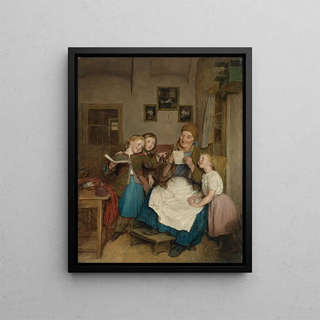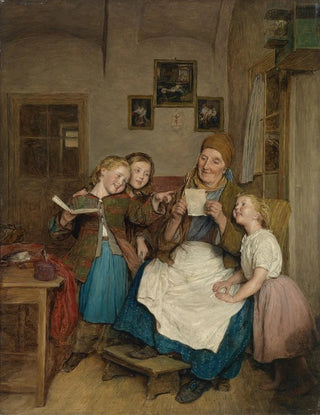Art print | Grandmother with three grandchildren - Ferdinand Georg Waldmüller


View from behind

Frame (optional)
Grandmother with three grandchildren - Ferdinand Georg Waldmüller – Captivating Introduction
The canvas "Grandmother with three grandchildren," an iconic work by Ferdinand Georg Waldmüller, stands as a true ode to familial tenderness. In an intimate setting, the artist manages to capture a simple and moving moment of life, where the wisdom of the elders meets the innocence of youth. This scene, imbued with warmth and gentleness, invites us to immerse ourselves in a universe where time seems suspended, where every exchanged glance between the characters tells a story. Waldmüller, master of genre painting, succeeds in immortalizing this unbreakable bond between generations, making this artwork a precious testament to family love.
Style and uniqueness of the work
Waldmüller’s style is characterized by striking realism, combined with profound sensitivity. In "Grandmother with three grandchildren," the meticulously detailed elements, from facial expressions to fabric textures, demonstrate great technical mastery. The warm and luminous colors create a welcoming atmosphere, conducive to contemplation. The composition of the piece, focused on the characters, highlights the interaction between the grandmother and her grandchildren, symbolizing the transmission of values and traditions. Every element of the canvas, whether it is the soft light illuminating the scene or the delicate gestures of the children, contributes to the overall harmony, making the work both lively and timeless. Waldmüller succeeds in transcending the simple family portrait to create a true celebration of life and love.
The artist and his influence
Ferdinand Georg Waldmüller, born in 1793 in Austria, is one of the major figures of the Romantic movement. His artistic journey is marked by an incessant quest for truth and beauty in everyday life. Influenced by the great masters of the past, he develops a style that is uniquely his own, blending realism and emotion. Waldmüller is distinguished by his ability to depict scenes of daily life with rare psychological depth. His work, often centered on human relationships, has profoundly influenced his contemporaries and continues

Matte finish

View from behind

Frame (optional)
Grandmother with three grandchildren - Ferdinand Georg Waldmüller – Captivating Introduction
The canvas "Grandmother with three grandchildren," an iconic work by Ferdinand Georg Waldmüller, stands as a true ode to familial tenderness. In an intimate setting, the artist manages to capture a simple and moving moment of life, where the wisdom of the elders meets the innocence of youth. This scene, imbued with warmth and gentleness, invites us to immerse ourselves in a universe where time seems suspended, where every exchanged glance between the characters tells a story. Waldmüller, master of genre painting, succeeds in immortalizing this unbreakable bond between generations, making this artwork a precious testament to family love.
Style and uniqueness of the work
Waldmüller’s style is characterized by striking realism, combined with profound sensitivity. In "Grandmother with three grandchildren," the meticulously detailed elements, from facial expressions to fabric textures, demonstrate great technical mastery. The warm and luminous colors create a welcoming atmosphere, conducive to contemplation. The composition of the piece, focused on the characters, highlights the interaction between the grandmother and her grandchildren, symbolizing the transmission of values and traditions. Every element of the canvas, whether it is the soft light illuminating the scene or the delicate gestures of the children, contributes to the overall harmony, making the work both lively and timeless. Waldmüller succeeds in transcending the simple family portrait to create a true celebration of life and love.
The artist and his influence
Ferdinand Georg Waldmüller, born in 1793 in Austria, is one of the major figures of the Romantic movement. His artistic journey is marked by an incessant quest for truth and beauty in everyday life. Influenced by the great masters of the past, he develops a style that is uniquely his own, blending realism and emotion. Waldmüller is distinguished by his ability to depict scenes of daily life with rare psychological depth. His work, often centered on human relationships, has profoundly influenced his contemporaries and continues






